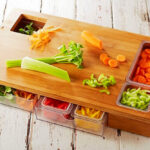When it comes to cooking, having the right tools makes a world of difference. Two essential tools in any kitchen are a set of chopping boards and a set of utility knives. A good chopping board set not only protects your countertops from knife marks but also provides a stable surface for chopping vegetables, fruits, and meats. On the other hand, utility knives come in handy for various tasks in the kitchen, from slicing bread and meat to cutting vegetables and fruits with precision. In this guide, we’ll go through everything you need to know about choosing the right chopping board set and utility knives for your kitchen.
Choosing a Chopping Board Set

The first step in choosing a chopping board set is identifying what material you prefer. Chopping boards come in various materials, including plastic, wood, glass, and bamboo. Plastic boards are the most common and inexpensive. They are also dishwasher safe and don’t require much maintenance. However, they tend to dull knives quickly, and they are not biodegradable. Wooden chopping boards are the most popular choice. They are durable, gentle on knives, and don’t harbor bacteria easily. However, they require more maintenance than plastic boards. Glass and bamboo boards are also great options, but they are not gentle on knives.
Another thing to consider is the size and number of boards in the set. Chopping board sets come in various sizes, from small to extra-large. If you have limited kitchen space, it’s best to go for a set with a few medium-sized boards. Also, consider the color-coding feature in some sets. A color-coded set helps prevent cross-contamination when chopping different foods.
Choosing Utility Knives
When it comes to utility knives, the options are endless. The most common types of utility knives are the chef’s knife, paring knife, serrated knife, and bread knife. The chef’s knife is an all-purpose knife suited for chopping, dicing, and slicing. Paring knives are ideal for more delicate tasks such as peeling and trimming. A serrated knife comes in handy when cutting bread and tomatoes as it has a serrated edge that cuts through tough skin and soft interiors. Lastly, a bread knife has a long, serrated blade that makes it ideal for slicing bread in a sawing motion.
When choosing a utility knife, consider the handle and blade material. Utility knife handles come in various materials, from plastic to wood and metal. Choose a handle that is comfortable to grip and has a non-slip feature. For the blade, there are two options: carbon steel and stainless steel. Carbon steel is more durable and holds its sharpness longer, but it requires more maintenance to prevent rusting. Stainless steel, on the other hand, is rust-resistant and requires less maintenance but dulls quickly.
Taking Care of Your Chopping Board Set and Utility Knives
To keep your chopping board set and utility knives in top condition, proper care is crucial. For chopping boards, always wash them with soap and water after use, especially after cutting raw meat. Sanitize them regularly with vinegar or a mixture of hydrogen peroxide and water. If you have a wooden chopping board, apply food-grade mineral oil to keep it from drying out. For utility knives, always hand wash them with mild soap and water, and dry them immediately after washing to prevent rusting. Sharpen the blades regularly to keep them in top condition.
Our Top Picks for Chopping Board Sets and Utility Knives
When it comes to chopping board sets, we recommend the Totally Bamboo 3-Piece Bamboo Cutting Board Set and the OXO Good Grips 3-Piece Nylon Cutting Board Set. These sets come with medium-sized boards that are gentle on knives and have a color-coding feature. For utility knives, our top picks are the WÜSTHOF Classic 8-Inch Chef’s Knife, the Shun Classic 3.5-Inch Paring Knife, and the Mercer Culinary Millennia 10-Inch Wide Bread Knife. These knives are durable, comfortable to use, and offer excellent precision and control.:
In conclusion, choosing the right chopping board set and utility knives is crucial for any kitchen enthusiast. When selecting a chopping board set, consider the material, size, and color-coding features. For utility knives, consider the blade and handle material and the type of knife that suits your needs. To take care of your chopping board set and utility knives, proper care is vital, including regular cleaning and sharpening. At the end of the day, investing in high-quality chopping board sets and utility knives will save you time, money, and frustration in the kitchen.
